The Odyssey on Angel Island
Conceived and directed by Ava Roy
Original score by Charlie Gulke
May 12 — July 1, 2012
We Players
Angel Island State Park, California
(reviewed performance: June 2, 2012)
Review by Al Duncan
University of Utah
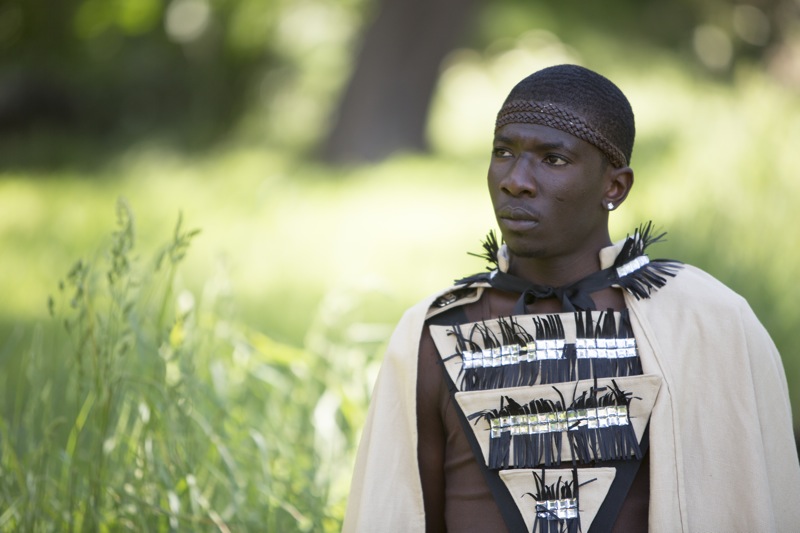
Image 5 | ||
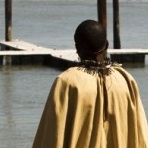
Image 1 |

Image 2 |
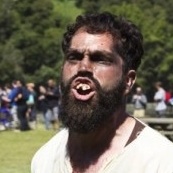
Image 3 |

Image 4 |
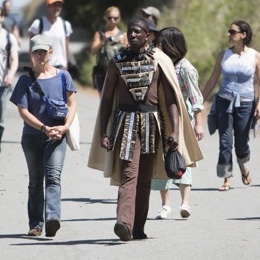
Image 6 |
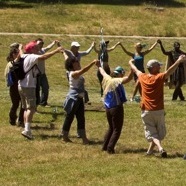 Image 7 |

Image 8 |
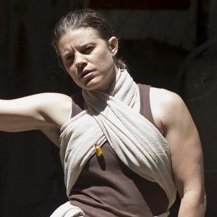
Image 9 |
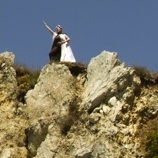 Image 10 |
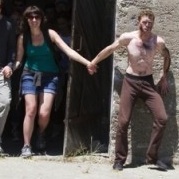
Image 11 |
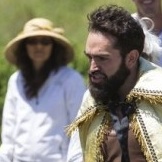
Image 12 |
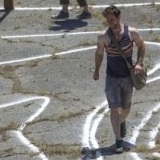 Image 13 |

Image 14 |

Image 15 |
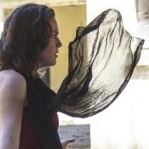 Image 16 |
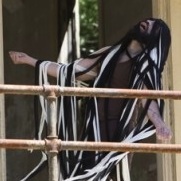
Image 17 |

Image 18 |
 Image 19 |
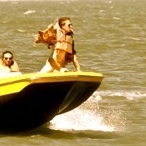
Image 20 |

Image 21 |
 Image 22 |
The Odyssey on Angel Island presented a reshaped Homeric Odyssey with creative and substantial modifications for the theater. The production followed Telemachus as he undertakes an extended journey in search of clues about his father, retracing the wanderings of Odysseus in the process. With scenes presented at numerous locations along a four-hour walking tour of Angel Island, a California State Park with panoramic views of the San Francisco Bay, the production showcased the beauty and historical importance of the park.
Put on by We Players, a theatrical troupe founded by the show’s director, Ava Roy, and dedicated to “transforming public spaces into realms of participatory theater,” the Odyssey on Angel Island (henceforth, OAI) transported its audience from Ithaka to the Cyclops’s cave and back, engaging Aeolus, sirens, Lotos-Eaters, Circe, and Calypso on the way.1
Effective and evocative use of space was a highlight of the OAI, which exploited the episodic nature of Odyssey Books 9–12 to lead the audience on a six-mile scenic tour along the island’s Perimeter Road. Walking interludes between each fixed location often allowed for graceful, if sometimes slow, transitions—not only between performance spaces, but also between performance modes. Each scene had its own distinct character and mood, ranging from more or less traditional static theatrical performance to voyeuristic encounters with tableaux vivants, anthropological observations of bizarre ritual, and moments of hands-on participation reminiscent of children’s theater.
Because of the production’s numerous changes of location and mood over the protracted performance, noteworthy decisions regarding staging and storytelling occurred in every scene. An episodic review, accordingly, can best convey the narrative flow and design behind the presentation, though I fear the sprawling nature of the show has resulted in a similarly profuse review. In the end, I will offer summary thoughts on the many strengths and very few weaknesses the OAI as a whole, and comment on how the production illuminated some of the challenges and opportunities encountered in transforming Homeric epic across cultures, genres, and performance modes.
A Feast at Ithaka (In front of Angel Island Visitor Center)
From the outset, the play’s setting on Angel Island presented a number of difficulties cleverly overcome in production. Ferries (from San Francisco, Oakland, and nearby Tiburon in Marin County) brought audience members and other day-trippers to the island’s northwest side, docking in short succession on a small pier in Ayala Cove (Image 1). Rather than hold the show until the whole audience was present, early arrivals were rewarded with half an hour of ad lib interactive theater. Upon disembarking, each audience member was greeted with a playbill/map of the island as well as a tote bag filled with unexplained supplies.
After a short walk we were welcomed to the lively forecourt of Ithaka. There, Penelope's jolly suitors intermingled with the new arrivals, sharing almonds and other light snacks, drinking songs, impromptu dance, and games of tug-of-war (Image 2). The ensemble cast of suitors, played mostly by women sporting period-neutral, loose-fitting browns and equipped with swashbuckling mien and adhesive Van Dykes, cordially but insistently invited new arrivals to take part in the merriment and feast. The suitors’ inclusive cajoling, in the style of Tony n’ Tina’s Wedding, made spectators immediately and at times unwillingly complicit in the consumption of Odysseus’ wealth. Like Persephone in the underworld or Eve in Eden, with a bite we were brought within a predetermined course of events.
The shift from the omniscient narrative of epic to the embodied, embroiled, and individual vantage points of participatory theater had profound effects. On Angel Island, Homer's overweening suitors became more complex and sympathetic. Vivacious, droll, attractive—it was hard to blame any but the most egregious of the suitors for their revelry. Like the audience among whom they walked and fraternized, the suitors were simply out to have a good time. We audience members, having both paid a substantial ticket price and endured choppy surf just to arrive, felt entitled to the spoils.
The audience’s willingness to go along with the suitors was further enabled by their collective assent to “make-believe.” The realities underneath the costumes and fantasy had an impact on the ethics and aesthetics of performance. Since the suitors were clearly women beneath the whiskers and tough-guy attitudes, their threat of forced sexuality and violence—upon Penelope, her maids, even the audience—felt somewhat insubstantial. The suitors’ power was social: the audience, expecting to follow cues and directions, could hardly avoid falling under their command.
From the opening free-form festivities, a sequential narrative gradually began to coalesce. Phemius, a curly-haired folk singer with acoustic guitar, began to sing “The Fall of Troy”—the first of a handful of original songs in the production, composed by Charlie Gulke, with memorable hooks. By the third chorus and, as often, following the suitors’ boisterous lead, the audience was mostly singing along.
But in part because of its repeated hook, the “The Fall of Troy” offered few details about the sad homecomings of the Achaeans, focusing instead on events of the Trojan War itself. As a result, when Penelope bursts into the scene to halt Phemius mid-performance, her emotional interruption came across as strikingly under-motivated. There was little of that famous circumspection and endurance which characterize the Homeric queen. This was perhaps the sole moment in the OAI where epic was poorly or awkwardly adapted to the stage. An Iron-Age bard could simply report how Phemius “sang about the Achaeans’ sad return from Troy” (Od. 1.326-7). But to express the “same” event, drama much prefers to embody the performance, using pathetic lyrics to pull at the heart-strings—not only Penelope’s but those of the audience as well. Annalistic reporting, even in song, is simply not enough.
Brusquely cutting off Penelope at this point was not Telemachus, but an unruly suitor named Melanthius—a real Thersites of a man with protruding yellowed teeth, squalid hair and dress, a hobbled gait, and prominent scars (Image 3). Derisible alike in appearance and manners, Melanthius proved an able jester, a source of comic relief that was much appreciated in this awkward interchange between Telemachus and Penelope in front of the suitors. Melanthius was equipped with salacious retorts and punchlines for every occasion. The suitors on Angel Island’s Ithaka were more than just overweening: they were amusing.
Following the Homeric order of events, Athena next arrived disguised as a beggar, a silver headband serving as a “visual aside“ to signal her divinity exclusively to the audience (Image 4)—and possibly also to sensitive souls like Telemachus. By means of this quiet introduction to the language of the OAI’s costume (immortals were consistently marked either by silver, gold, or sparkles), Athena’s identity and purpose were unobtrusively but immediately recognizable to those familiar with the epic. The story could therefore begin in medias res, without a divine council, and direct our focus straightaway on Telemachus instead of his father.
The second avatar in which Athena encounters Telemachus in the Homeric Odyssey—that of Mentor—might have posed knottier problems for production. While Homer may simply inform us that Athena comes to Telemachus “appearing in body and voice like Mentor” (Od. 2.268), theater and film typically must laboriously set up such changes of internal identity. We Players came up with a clever and topical solution: using a steep slope on the island, Athena silently stood several yards above the aged Mentor, himself several yards above Telemachus, dramatically schematizing the chains of divine influence and paternal command so familiar from the Odyssey. As Athena silently raised her arm over the action unfolding below, it became clear that Mentor, his demeanor suddenly changed, was channeling her words. With this deft maneuver, the OAI also sidestepped a potential objection to the Homeric epic: Why do two “Mentors” fail to cause confusion on Ithaka?
Having been instructed by Athena/Mentor to form a search party for news of his father, Telemachus—in this production a handsome, strong, but guarded youth hardly in need of Bildung (Image 5)—asks for volunteers to accompany him on his journey. The audience (on this Saturday, mainly middle-aged patrons clearly familiar with Homer's Odyssey and apprehending their cue) raised their voices and hands in favor of following Telemachus, leaving the suitors behind to revel and jeer.
Aiolia (Camp Reynolds, West Garrison Parade Ground)
After a 15 minute walk, the first of many such strolls (Image 6), Telemachus and his audience-crew arrive at Aiolia, land of the winds. The scene took place in the lower half of a sloping military parade ground at the historic Camp Reynolds, a rectangular sward opening out to the west. Photographers (of whom there were more than a few in our party) were quick to snap postcard-ready shots of the Golden Gate Bridge and sunny Sausalito before joining the action. The lower lawn swarmed with playful sprites—quickly discernible as the erstwhile suitors, though now wearing iridescent blues, greens, and purples—who equipped the audience with streamers and hoops. No one could help feeling like a child again in such a Neverland, surrounded by so many Tinkerbells. King Aeolus (the erstwhile Melanthius), with booming voice and glittering mascara, was bringer of jollity and master of ceremonies, commanding all to form a giant circle and join in a hastily rehearsed dance in the round (Image 7).
Such youthful play might well come as a surprise to those familiar with the sparse description of Aiolia of Odyssey 10. In situ the dance, sprites, colors, and movement all stood in marked, yet fitting, contrast to the rectilinear and militaristic parade ground, flanked along its length by whitewashed, clapboarded, and decidedly dead barracks. Though Aiolia was certainly not the first stop made by Odysseus and his crew after departing from Troy, the juxtaposition of human and divine kingdoms was dramatically effective. We the audience found ourselves once again unannounced guests at a party, but this time the king was present to bid us freely join in the merriment, even providing Telemachus with a parting gift: a bag of winds to speed us on our way after Odysseus.
A large, century-old brick building at the dock served as our ship. We crowded in, finding seats wherever we could in preparation for the “voyage.” At the fateful moment when the winds were let out of the bag, frantic drumming erupted from above and blackout cloths fell over the windows. We were thrust into darkness and, with the incessant pounding from above, felt uncomfortably claustrophobic. When through the obscurity Telemachus opened an unnoticed door, the shaft of light and clear exit created detectable relief among the audience. Stagecraft had injected fear and perceived physical urgency into the performance while keeping the all-ages audience safely seated and—insofar as an audience can be—passive. A mere fifty hexameters of Homeric narrative thus became one of the more energetic moments in the OAI.
Siren (Battery Ledyard)
Next on our walk around the perimeter of the island we passed a vignette, nearly a hundred feet below and away from the road, of a siren in a billowing nightgown chained to the remains of a concrete Endicott artillery battery on a scraggy bluff, with the Golden Gate and San Francisco in the background. The scene partially captured the dangerous and uncanny allure of the Homeric sirens, but the distance precluded any immediate fear of being lured to our deaths and, with the wind, kept us from hearing any singing, though we had no wax in our ears.
This tableau vivant was poorly contextualized. Reference to the playbill/map was needed to understand that this was, in fact, a siren, and not simply a dream-like image of a struggling Penelope, as both roles were played by the same actor. According to the playbill, the sirens on Angel Island were indeed a mirage, “[tempting] travelers by taking the shape of their desires.” With the production’s focalization through Telemachus, it was natural (though certainly not inevitable) to interpret the appearance of this siren as a Freudian desire, and the scene, at least to this reviewer, came across as somewhat Oedipal, even sadomasochistic. If it was Odysseus’ rather normative desire while stranded on Calypso’s island to see his wife (Od. 5.209-210), the audience on Angel Island was prompted to ask whether it was Telemachus’ subconscious desire, or perhaps our own, to gaze upon his sexualized mother in bondage.
The Lotos-Eaters (Battery Wallace)
Minutes later, directed in our quest by sundry spritely gods (outfitted with gold lamé and a bicycle to match, Image 8) we arrived at the Land of the Lotos-Eaters. There we came upon a ritual scene taking place in another decommissioned battery. Invited to sit on the upper levels of the quasi-brutalist concrete, we looked on, around and below, as actors transported water with Sisyphean purpose from certain vessels to others, each vocally contributing to a low and monotonous "ahh" (Image 9). There was no “eating” as such, and it was explained (again in the playbill) that the Lotos-Eaters “drink the nectar of the forest in search of the Great Spirit.” The scene ostensibly represented a religious service in pursuit of some form of communion, but the blank expressions and hum of the actors, combined with the methodical pouring of water, came across as strikingly funereal, particularly to classicists familiar with the role of water in Greek mortuary practice.
The post-apocalyptic ceremony reached its climax in a shrieking, unintelligible prophecy. A draught of the nectar was poured into the mouth of a sybil. With arms strung up to heavy iron rings by white cloths, the woman raved and spasmed in the battery’s hull in an aesthetically striking, and thoroughly uncomfortable, spectacle somewhat reminiscent of the beginning of Aeneid book six.
In opposition to the blithely contented Lotophagoi of the Odyssey, as well as our preceding gaieties on Angel Island’s Ithaka and Aiolia, this strange cult seemed to offer little chance our band might dally under its thrall. The Lotos-Eaters of OAI represented a dark side of the fantasy world into which we had entered, a gloomy sobriety that counterbalanced the mirth and mayhem of suitors and immortals. When Telemachus called out suddenly, "Friends, we must go. It is not safe here," he did not have to ask twice.
A Divine Council (Old Quarry)
We ascended from the quasi-infernal land of the Lotos-Eaters into the realm of the immortals, stumbling upon Mount Olympus. Perched atop the crags of an old quarry, stones from which were used to build the infamous prison on Alcatraz, a small quorum of gods had met to discuss Odysseus’ fate (Image 10). Thirty yards away, above and beyond the audience, the Olympians employed outsized voices and gestures for the benefit of us mortals below. The intentional over-acting—combined with low-brow humor, notably in the form of Hermes’ pelvic thrusts when recounting Odysseus’ amorous exploits—was pitch-perfect camp. The comic gods sped our emotional recovery in the wake of the bizarre and troubling rituals of the Lotos-Eaters. The divine council underscored the separation between sans-souci immortals and suffering mortals often observed in the Homeric epics.
The Cyclops’s Cave (Battery Drew)
Telemachus and our company continued next toward the Cyclops’ cave, an underground bunker attached to the former Battery Drew. Before entering, Telemachus warned us with a knowing wink that claustrophobes might want to sit this adventure out and "stand guard" while the rest crowded into the unlit cave. Once the majority of us were crammed like sardines inside, the door slammed shut from behind. The audience, once again, was suddenly plunged into total darkness. Only when the nervous murmurs of the audience crew died down did we begin to hear the pained sobs of the Cyclops, apparently still somewhere within the echoic bunker, mourning the loss of his eye at the hands of "Nobody." Telemachus, avoiding the unnecessary confrontation with the monster which his father had recklessly baited, discreetly instructed us to reach inside our provisions sacks, where matches were found to light our exodus. Leaving the bunker by a second door (Image 11; in this way, the cave was more like Philoctetes’ than Polyphemus’), we were greeted by a giant stake with blood-stained tip, pointing us toward those standing guard.
There was not a single sheep nor any clear and present danger in this Cyclops’s cave. But the tools of theater—light and darkness, dramatic irony, memory, and audience competence—made a compelling story out of what was essentially a forensic or archaeological endeavor.
In tracing Odysseus’ footsteps, we confronted the lasting impact of the hero’s energetic and serial wanderings. While King Aeolus might have sung Odysseus’ praises to Telemachus during our visit, Polyphemus (apparently still ignorant of his attacker’s real name, thereby abandoning the Homeric curse against Odysseus) was a real, if invisible, victim of Odyssean violence. Like detectives on a breadcrumb trail, the audience was left to ask what kind of man we were tracking.
Scylla and Charybdis (Nike Missile Site)
Reunited only for a short time, the audience was met at a fork in the road by a solitary Zeus who offered a choice of three routes, varying in the degree of physical exertion required (Image 12). The most athletic “heroes” were invited to follow Telemachus and run a quarter mile to the site of a former Nike Missile battery. After hastily but duly signing a waiver, these heroes were faced with a dynamic obstacle course. Managed by a dirty brute (Charybdis), the swirling course featured crawls through corrugated pipes, high-stepping through tires, and climbs over rope nets, all under the shadow of a thirty foot air-dancer balloon (Scylla) which, while not threatening in the least, added visual energy and movement to the course as Charybdis pounded steadily on a large drum (Image 13). A second group of heroes observed and cheered the spectacle from a cliff overlooking the site, while the remaining third of the expedition walked ahead to a musical performance in a church at Fort McDowell.
The choice of adventures was in keeping with the participatory nature of the production and, coming at approximately the half-way point of the performance, was well-timed to offer either rest or further stimulation to those who may not have been naturally suited to the pacing of the OAI.
Circe’s Palace (Post Hospital, part of Fort McDowell, East Garrison)
The audience reunited at a three-story abandoned building, the former Post Hospital of Fort McDowell (Image 14), in which a ground-level room held a banquet table loaded with almonds, dried fruit, and cheeses. Nearly three hours into the production at this point, we eagerly helped ourselves to the good things before us, like Odysseus’ unruly crew. While munching, one could wander through the building’s decay—around broken tiles, peering through holes in walls with peeling paint and splotched stucco. The eeriness of the skeletal structure was enhanced by the production: stuffed birds, sun-bleached horn racks, and other animal remains created the unsettling feel of a taxidermist’s parlor. An upright-bass player, standing alone in a doorless closet, droned on with a scratchy, irregular timbre.
The magical Circe at length appeared in a rather gothic prom dress (Image 15), trying a bit too hard to seductively welcome Telemachus who, even without moly in hand, was prepared for the sorceress’s advances and turned them to his advantage. After purifying Telemachus in a clawfoot tub (Image 16), Circe pointed the way to the Underworld, which—to the relief of Telemachus’ sole-sore crew—was part of the same building complex.
Underworld (Post Hospital, part of Fort McDowell, East Garrison)
In a multi-story ritual in the open courtyard of the former hospital, Telemachus convened with the souls of the dead, taking the search for clues of his father to the very opposite end of the island. Supernumerary dead appeared in dirt-brown tribalesque costumes, floating and twisting waifishly above us on the second floor, where their presence was appropriately menacing, if somewhat inappropriately elevated (Image 17).
Ritual structures of performance helped map the translation of epic narrative onto drama. Slow, methodical, and mysterious, these moments controlled the pace of production, setting moods of dread and somber expectation. The intellectual fruits of director Ava Roy’s self-designed undergraduate major at nearby Stanford, Ritual and Performance in Aesthetic Education, were evident in this production. The emotional pendulum of the performance, oscillating between the poles of mirth and dread, mystery and conflict, gave a sense of forward movement combined with artistic repetition which, with the periodic walks, kept the marathon performance from becoming too dull.
Siren’s Reprise (Barracks, part of Fort McDowell, East Garrison)
We next set out to confront Calypso, who we were informed had been holding Odysseus captive. In transit, we passed a second siren, again remote (Image 18). No longer chained, this phantasm wandered listlessly along the upper floors and empty window frames of an old military barracks, dropping amorous notes that glided, leaf-like in the breeze, to the ground. Again, the context and meaning of the siren’s presence were unclear. And once again, it was tempting to interpret the image as an abandoned and lovelorn Penelope, on this occasion emotionally rather than physically repressed.
Regardless of whether one interpreted the siren as Penelope in particular, or else as an anonymous and distantly erotic female, the siren’s dreamlike appearances projected the queen’s predicament on Ithaka—loss, loneliness, stasis—and helped maintain the locational dialogue between home and periphery, Ithaka and foreign lands, so essential to the narrative structure of the Odyssey.
Calypso (Quarry Beach)
The final stop on the outbound journey placed us on Quarry Beach, which offered a southward vista stretching the entire span of the Bay Bridge from Oakland to San Francisco. Lazing around an impromptu shelter of roughly cut branches and white sheets, a lovely Calypso in green and blue—colors reminiscent of the sprites of Aiolia (Image 19)—was a lounge singer, backed-up by the talented but small band of musicians featured before in several scenes. The mood was that of a 1940s beach cabana, and the audience was put in the position of haggard tourists stumbling into a local venue filled with intrigued, if nonplussed, locals.
For the first time since we had left Ithaka, the scene was populated by vibrant extras with what might be called a “grown-up” theme. One could imagine Odysseus happily choosing such a place—filled with the pleasures of sun, surf, song, and divine sex—for a vacation home. And yet the materials for the hero’s escape lay before our eyes. Though this may not have been a conscious intention of the production, the rough-cut timber and airy sheets which formed Calypso’s beachside hut could easily be imagined, broken down and reconstituted, as a raft to carry Odysseus on his journey home.
We ourselves were falling for Calypso’s charms and song when Hermes, pelvis yet again thrust forward, arrived not by raft but by motorboat (Image 20) and made known the will of the gods through a loudspeaker: Like Odysseus before, we must now be let go.
The production of this scene was impressive, even beyond the musical accompaniment. It was clear that the actor playing Hermes could not hear his cues over the sputter of the outboard motor, so his megaphone pronouncements followed subtle visual cues from Calypso and Telemachus. The well-timed arrival of the motorboat was in some respects the climax of the entire production: jovial, exuberant, authoritative, it was literally the turning point (as the boat cut left and right across the waves) in the course of events, sending Telemachus back to Ithaka. Divine modes of transit (bicycle, motorboat) and divine modes of communication (physically distanced, loud, and over-the-top) marked the gods’ superiority over us pedestrian, quietly murmuring mortals.
Homecoming in Ithaka (Outside of Angel Island Visitor Center)
After taking our own vehicularly enhanced ride around the remaining perimeter of the island, we at last returned to Ithaka. There we found the most audacious of the suitors, Melanthius, gruesomely maimed, bathed in his own blood, sitting on the ground outside the palace (Image 21). As noted at the outset, the character was a true Thersites—an ugly trash talker, now violently struck down by Odysseus, whose homecoming we had apparently just missed. Melanthius’ comeuppance, like Thersites’, invited an ethically ambiguous response from our 21st-century audience. While this man was certainly a nuisance, summary violent punishment does not well accord with our notions of justice or due process. His wounds, seemingly mortal, prompted a sense of survivor’s guilt. We too, after all, had partaken of the free food and festivities at Ithaka.
No longer in the palace and certainly not testing his wife with knowledge of his arboreal bed frame, Odysseus had already left Penelope, now twice abandoned (Image 22). The absent hero’s motivations, as often, were unclear. The carnage left behind, this time on his own land, appeared to be the result of an indiscriminate, possibly post-traumatic, rage. This—from what the audience could piece together of the survivors’ speeches—was no simple wanderlust, no Tennysonian rejection of rusting unburnished at home. Odysseus’ return to Angel Island’s Ithaka was simply the latest in a long series of aggravated assault.
As the play came to a close, we were left without a clear sense of who, exactly, this Odysseus we had been tracking was: a hero, madman, or somewhere in between? That we never encountered the man himself, but only his destruction and dalliances, was central to the production’s emotional and moral effects. No noticeable allusion was openly made to the rather nefarious Odysseus of Attic tragedy, but the self-interested and violent malfeasant of Sophocles’ Philoctetes might well have fit the mold left by Angel Island’s absent father.
The disconnect between the Homeric and dramatic Odysseuses did cause some tension in the OAI. Throughout the production, as in the Homeric epic, Telemachus’ resemblance to his father was noted by Odysseus’ old acquaintances. But our cautious and heroically nondescript leader could not readily be reconciled with the wreckage left by his father. Even before the return to Ithaka, it was hard to imagine that a cordial reunion between father and son would be in the future. The character of Odysseus seems almost doomed to a violent or mad incarnation in tragedy. He is a hero who, despite his cunning, becomes more akin to the mad Heracles than the politic Theseus when thrust upon the stage.
General Points of Interest
Even with the marathon length of the Odyssey on Angel Island, parts of the Homeric narrative were notably absent. Most significantly, the Phaeacians were completely deleted. In this island filled with divinities and monsters, there may not have been conceptual space for a human court outside of Ithaka, our point of departure from and return to the “real world.” More pragmatically, given the experiential nature of the production, there was no need for an oral recounting of Odysseus’ wanderings, which is perhaps the most essential “action” to take place on the Homeric Scheria.
However, with no Phaeacians there could be no Nausicaa, which was a bit of a shame. Circumspect, nubile, and thoroughly unobjectionable in the epic, Nausicaa might have served as an appropriate romantic pairing for Telemachus. Indeed, such matchmaking between Odysseus’ “legitimate” and “secondary” families has fascinated carriers of the epic tradition since at least the lost cyclic epic, Telegony, in which Telemachus marries Circe and Penelope, in turn, weds Telegonus, Circe’s son by Odysseus. But in general the OAI eschewed romance. What eroticism was present was typically marked by female seniority or maternalism (the women Telemachus met on the journey were, after all, divine consorts of Odysseus), contributing to general subtext of a Freudian struggle against the father.
Telemachus’ encounters with Nestor and Menelaus were also cut, leaving out those reminiscences of the Trojan War which cast a positive light on Odysseus’ cunning. Beyond the praise of certain suspect figures, such as Aeolus and Circe, there was little to suggest that Odysseus was a decent man. Angel Island’s Telemachus, without distinct adventures of his own but rather retracing his dad’s footsteps, was denied the possibility for mutual admiration and wonder between father and son upon their reunion.
Strengths
Like the rest of We Players’ efforts, the Odyssey on Angel Island was a remarkable, one-of-a-kind production carefully crafted around a specific, culturally important space. The ensemble cast was uniformly strong, with a standout performance by Nathaniel Justiniano, whose outsized energy and many vivid characters (Melanthius, Aeolus, Zeus, and Polyphemus) filled the expansive locations of the production. James Udom as Telemachus was appropriately (that is, boringly) heroic. Cautious yet strong, Udom’s Telemachus became a likable and unobtrusive vehicle for the audience’s experience, a figure whose sly winks and shared glances with members of the audience fostered wordless bonds between captain and crew.
The directorial execution of this perambulatory production was nearly flawless. A strictly chronological sequence of events in the Homeric Odyssey—even those in Books 9-12—will almost inevitably be episodic and dull. It is the baroque structures of the epic narrative that allow the bard to foreground the pauses, parallelisms, and simultaneity which together contribute substantially to the poem’s suspense and general effectiveness. On Angel Island, in a production frequently punctuated by collective moment, sufficient time was given to critique, consider, and inwardly digest the sequence of events, chronological and episodic though they were. The inherent structures (physical, aesthetic, and practical) of a day-hike loop became a hodological skeleton upon which the imaginary “theater” of the production could be fleshed out. The OAI managed a beautiful marriage of location and story.
The location was nearly a character itself. The rich though repeatedly violent and unjust history of Angel Island—as missile battery site, fort, immigration and internment center—subtly underscored several themes within the Odyssey. The performance included no history lesson, and the playbill only briefly summarized the island’s past uses, but the settings themselves, decrepit but still formidable and even beautiful in their decay, silently provoked the question: How many Japanese-Americans, in addition to prisoners of war from Germany, Italy, and Japan, looked out longingly from the beaches and bluffs of Angel Island, so many Odysseuses held captive against their will?
More traditional theatrical adaptations of the Odyssey, such as Oliver Taplin’s excellent Wanderings of Odysseus, tend to get bogged down with words, despite often inventive and effective staging. As Aristotle recognized, even with their many thematic and formal similarities, epic is not adapted easily to the poetics of the theater. We Players’ participatory brand of theater came as close as possible, within a performance mode which one could easily recognize as theater, to the imaginary experience afforded by listening to the Homeric bard. Ostensibly members of Telemachus’ crew, we the audience—in our modern clothes and with scant agency in the course of events—were only partially incorporated into the fictional world. This ambiguity provided us with an aesthetically powerful vantage point: present but detached, we floated like spectral observers, immersed in the fantasy.
Weaknesses
And yet, the audience’s immersion without complete incorporation in the performance compromised some of the narrative’s ethical power. Without any of the stock methods for creating a Brechtian “alienation effect,” the audience’s partial presence in the scene—a motley crew with our jeans, backpacks, and sunblock—was a constant reminder that everything about the OAI was, more or less transparently, fictional. When we encountered a spectacle of suffering, be it the monstrous Polyphemus or the cadger Melanthius, our emotional responses were accordingly curtailed. It would have been interesting, if logistically complex, for the audience to have donned costumes and assumed characters in order to more fully create the fantasy world. The fact that the audience, repeatedly circling up around the action, were in constant view of one another had other limiting effects. Unable to shed a tear discreetly as they could in the relative privacy of an auditorium seat, and subject to the relentless demand for movement, audience members had little room to “let go” psychologically or to indulge in a moment of personal catharsis.
Despite its many efficiencies, the Odyssey on Angel Island was in the end a sprawling production. The actors—and, in this free-form theater, one could say the play itself—were self-consciously aware of their overextension. Telemachus’s constant refrain, “Friends, you must hurry,” was needed to herd the audience across the island, but his cajoling grated more with every repetition. Physical and mental stamina were required not only to experience but also to appreciate the show. The reflection that this four-hour long, midday production still took less time than a typical tragic tetralogy was sobering. As Edith Hall has noted, Attic tragedy’s “Suffering Under the Sun” was not limited to the events unfolding onstage, but was felt by those in the seats as well. On account of the time commitment demanded from the audience as well as a location with substantial local history and significance, the OAI managed to capture much of the festival nature of Attic tragedy in a natural and unobtrusive way.
Conclusion
In sum, We Players’ Odyssey on Angel Island took an intelligent spin on Homer’s Odyssey that was custom-fitted to its location, using ritual and participation to create a compelling dramatic production from a non-theatrical story. The OAI exploited theater’s inclination toward memory and discovery to recast Odysseus’ adventures within a historical past. Making use of Angel Island’s picturesque architectural remains and fraught but important history, the production blended theater with forensics, re-enactment with archaeology. Despite the audience’s best efforts to catch up with the warrior, Odysseus’ exploits had always already occurred, leaving only traces for our guide, Telemachus, to discover and follow through inquiry or exploration. Constructed out of events familiar from even cursory knowledge of the Odyssey, the OAI worked carefully around—as it engaged closely with—Homeric epic. In so doing, it was a worthy inheritor of a theatrical tradition forged in fifth-century Athens, but was very much present and alive in the San Francisco Bay.
[For their support, suggestions, and generosity the author would like to thank Mary-Kay Gamel, with whom he attended the production, David Jacobson, and Ava Roy.]
notes
1 I follow the spelling of names found in the playbill, even where divergent (cf. Aeolus and Aiolia).
